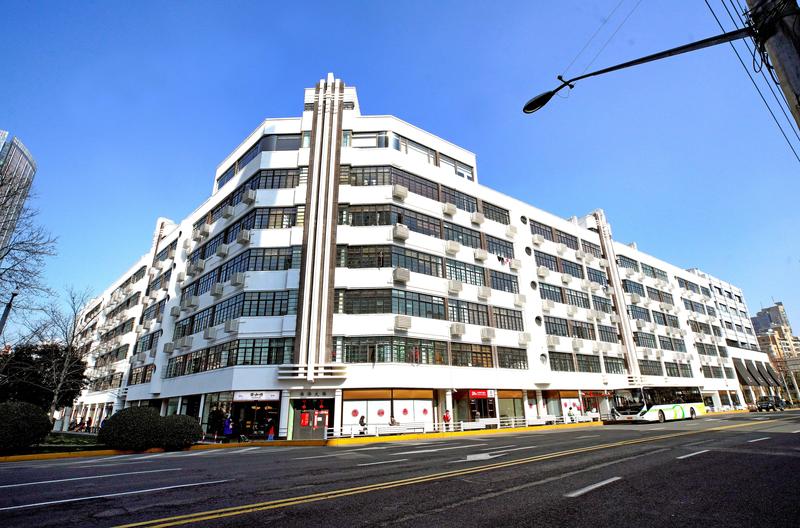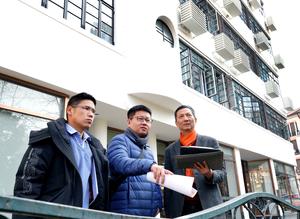Formerly a beacon of luxury and sophistication, an art deco apartment block in Shanghai is now undergoing renovations as part of the city's urban renewal efforts, Zhang Kun reports.
 Empire Mansions, which is widely considered one of the earliest luxury icons in Shanghai, is undergoing a facelift. (GUO XINYANG / FOR CHINA DAILY)
Empire Mansions, which is widely considered one of the earliest luxury icons in Shanghai, is undergoing a facelift. (GUO XINYANG / FOR CHINA DAILY)
Located at the junction of Huaihai Middle Road and Changshu Road in the former French Concession, the building widely considered to be one of the earliest luxury icons in Shanghai is currently undergoing a facelift.
Designed by renowned Chinese architect Huang Yuanji, Empire Mansions was an upscale locale that only the affluent could afford to live in when it was first built in 1934.
In the 1980s, the six-story art deco building went through its first major renovation, with new stories added to give it a more imposing presence.
In 1994, it became home to Maison Mode, which was believed to be perhaps the only place in the city that sold luxury products in the 1990s.
For many of the city's residents, the building was a beacon of inspiration for a better life.
"Empire Mansions used to represent my ultimate dream life when I was a teenager," recalls Shanghai resident Zhang Hong.
"I would stare at the beautiful women in high heels and trendy dresses walking past its dark iron gates. I couldn't help but think that they worked in big international companies and made a lot of money, because you needed to be quite well-off to afford those incredibly expensive clothing from Maison Mode.
"Back in those days, I would hesitate to spend even 100 yuan (US$16) on a shirt. In Maison Mode, the clothes could cost 1,000 yuan. I did not even dare to step inside the store."
The apartment block lost much of its glamorous sheen when Maison Mode vacated the premises in 2007. Taking its place was a branch of the Industrial and Commercial Bank of China, which was recently shuttered. The only standout business on the ground floor is currently Qiao Cafe, a new eatery that offers Chinese-Western breakfast sets. Most of the shop spaces are still awaiting new tenants.
Now, as part of a larger project by the Xuhui district authorities, restoring the historical charm of a 7.6-square-kilometer area around the Hengshan Road-Fuxing Road region, Empire Mansions is set to be restored to its former glory. Renovations to the apartment building are expected to be completed by June.
"The primary goal is to restore the original appearance of the architecture, remove potential hazards and optimize the overall environment," says Chen Zhongwei, general manager of Shanghai Construction Decoration (Group) Design Co Ltd, one of the companies involved in the project.
According to Chen, the exterior-renovation work involves adding new shelves on the facade for air conditioning units, changing more than 4,000 window panes and introducing new triangular shelves at the back of the building to allow residents to hang their clothes. On the inside, new ceramic tiles for bathrooms and new kitchen platforms were created.
He adds that Xufang Construction Industries Co Ltd, which is carrying out the work, is referring to the very first blueprint of the building to restore the structure of the shop fronts to the original, which features dark golden outlines and a textured concrete surface.
 Chen Zhongwei (right), general manager of Shanghai Construction Decoration Design Co Ltd, works on the project. (GUO XINYANG / FOR CHINA DAILY)
Chen Zhongwei (right), general manager of Shanghai Construction Decoration Design Co Ltd, works on the project. (GUO XINYANG / FOR CHINA DAILY)
Most of refurbishment work lies in the less-overt details. For instance, craftspeople have painstakingly restored the marble floors and copper fittings on the walls, as well as uncovered the charming wall lamps in the lobby that were concealed behind the columns in past renovations.
Chen, who has also worked on the restoration of landmark buildings, such as the Normandie Apartments and Blackstone Apartments, says that residents' feedback has also been taken into consideration.
Working together with the residents is a common aspect of such projects, he adds, noting that many homeowners and tenants are eager to do their part to help.
"There have been many occasions when people come up to me and ask what they can do to help preserve the architecture," he says.
"For this project, we had to remove the canopies that many households had installed outside their windows, but we also understood that the residents wanted some shelter from the setting sun in the late afternoon. As such, we had wooden shutters installed instead."
Empire Mansions is just one of the many buildings that are benefiting from the city's focus on implementing urban renewal while retaining the legacies behind historical architecture.
Pang Yuan, the honorary deputy chairman of China Estate Management Association, points out that the success of the Xintiandi project, which started 20 years ago, was what convinced the authorities of the efficacy of such an approach.
One of the most recent examples is the new Tsutaya Bookstore that opened in December within the restored Columbia Circle, which was a popular country club for Americans in the 1920s.
"The best protection for a historical building is to make good use of it," says Zhang Hai, CEO of the Shanghai Region headquarters of China Vanke, the developer of the Columbia Circle restoration project, during the launch of the Tsutaya bookstore.
"I hope to carry on the cultural heritage of the area and create a vibrant community and creative hub shared by residents and young career makers."
Over the past decades, Shanghai has enjoyed similar success with the renovation of its antiquated industrial facilities. For example, the former hangars, oil tanks and shipyards in Xuhui district now stand as museums in a thriving arts zone in the West Bund area.
Last July, Shanghai's efforts to preserve the tales behind its storied buildings were given a further boost with the establishment of an urban renewal center at Shanghai Land Group Co Ltd. During his visit to the center, Party secretary of the municipality, Li Qiang, spoke of the significance of such projects.
"The reformation of old areas and organic renewal of the urban landscaping are important projects that benefit people's quality of life and have to win full support from the people," he says.
Li adds that authorities will be implementing new working mechanisms and exploring new possibilities of urban landscaping renewal where State-owned enterprises can participate and play an active role. He also revealed that future renewal efforts will focus on such areas as Huangpu, Hongkou and Yangpu districts.
Last month, Gao Yun, the Party secretary of Huangpu, says that local authorities will be placing great emphasis on the renewal and restoration of its historical establishments. The district is home to more than 80 areas that are designated as historical communities under district protection.
Contact the writer at zhangkun@chinadaily.com.cn


